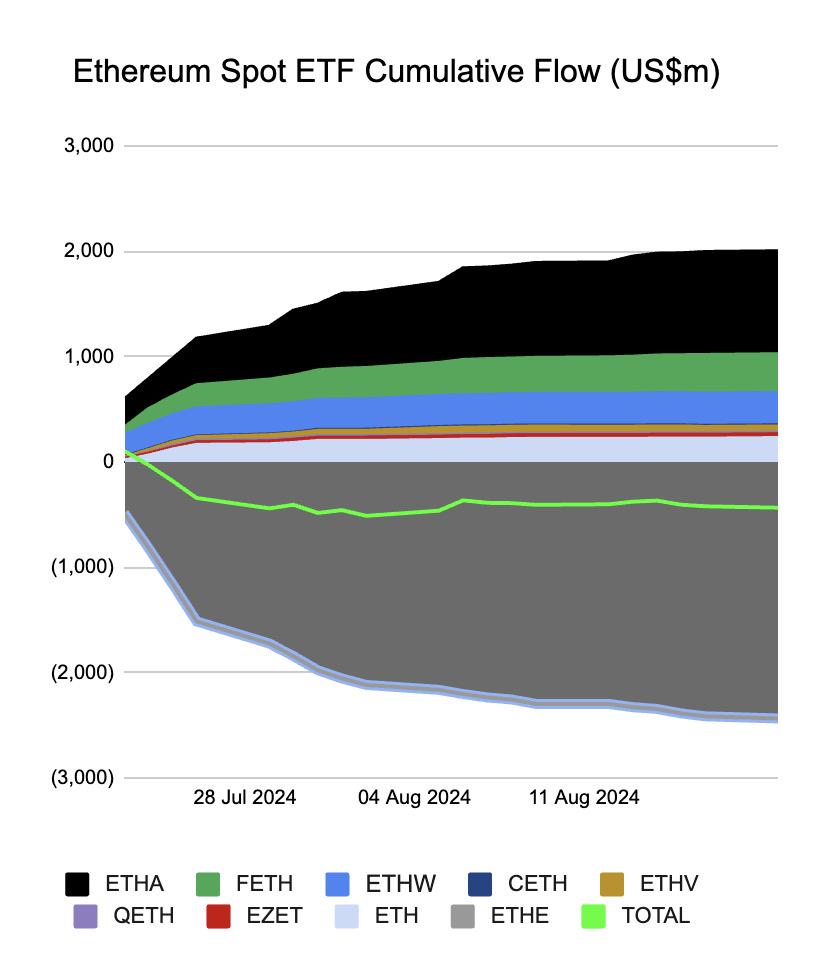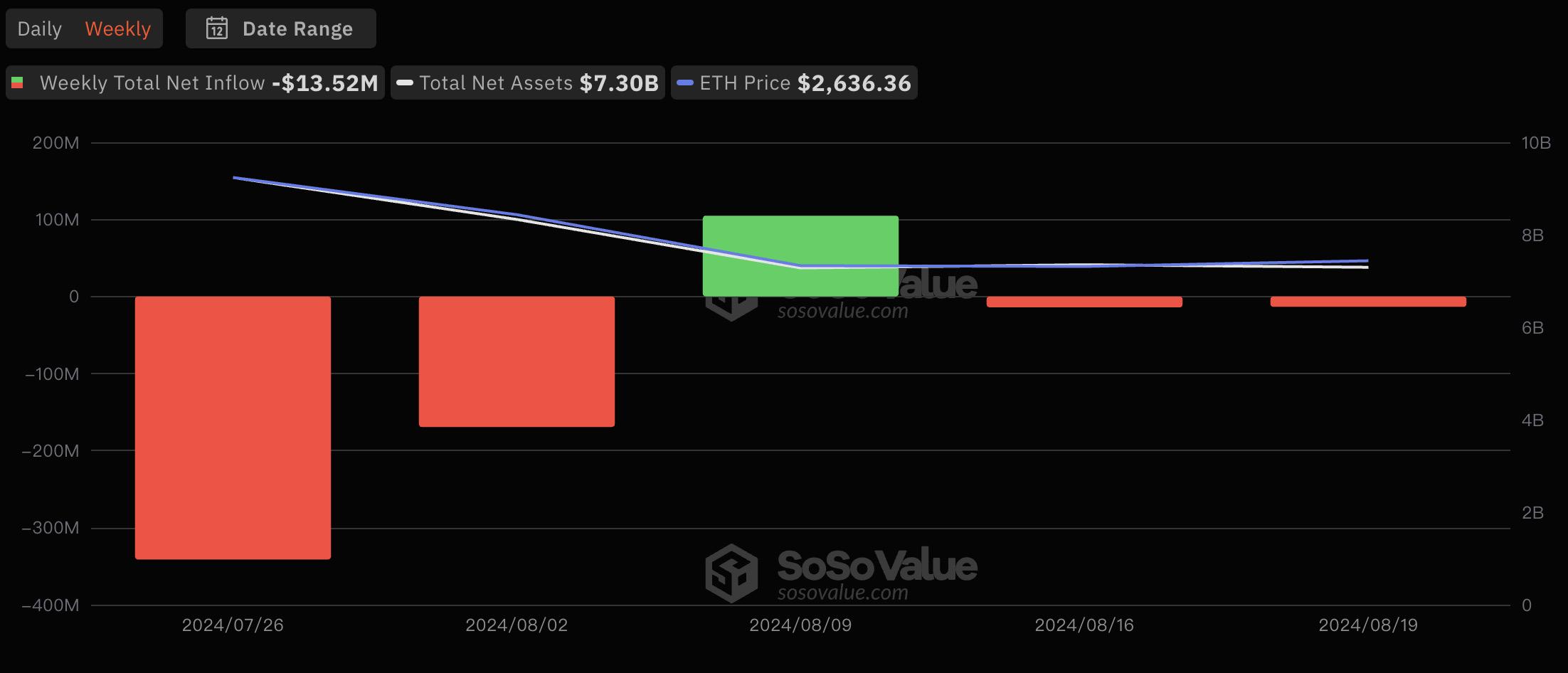Written by: Nancy, PANews
At present, while the Ethereum spot ETF is experiencing a large outflow of funds, multiple weak trends such as the weak downward trend of ETH prices and sluggish trading activities have continuously undermined the market's confidence in Ethereum.
The company lost more than $430 million in the first month of listing, and the outflow of funds slowed down.
Trading volume is a direct reflection of market sentiment and an investment indicator. Currently, the purchasing power of the nine Ethereum spot ETFs in the United States is insufficient, and the withdrawal of large amounts of funds also reflects, to a certain extent, the market's uncertainty and concerns about Ethereum's short-term trend.
In the first month of listing, according to SoSoValue data, as of August 19, the total net asset value of Ethereum spot ETFs reached US$7.3 billion, and the net asset ratio (market value to the total market value of Ethereum) was 2.32%. Among them, the top three ETFs in terms of market size are Grayscale's ETHE (US$4.48 billion, accounting for 1.54%), Grayscale Mini ETF ETH (US$950 million, accounting for 0.3%), and BlackRock's ETHA (US$840 million, accounting for 0.27%).
Compared with the slowdown in the withdrawal of funds from Bitcoin spot ETFs during the same period, Ethereum spot ETFs have not yet reversed the situation of continued capital outflow. According to Farside Investors data, as of August 19, these Ethereum spot ETFs have accumulated a net outflow of more than US$430 million. Among them, Grayscale's ETHE is the main "bleeding" camp. According to Farside Investors data, ETHE has withdrawn as much as US$2.43 billion in funds in the past month.

On the other hand, BlackRock's ETHA, Fidelity's FETH and Bitwise's ETHW have become the main force of "attracting money". According to Farside Investors statistics, as of August 19, the net inflows of ETHA, FETH and ETHW exceeded US$970 million, US$360 million and US$300 million respectively, accounting for 82.5% of the total cumulative net inflows of Ethereum spot ETFs (about US$2 billion).
Although Ethereum spot ETFs as a whole have shown a large net outflow trend, from the perspective of weekly fund flows, the outflow of funds from these ETFs has slowed down significantly in the four trading weeks after listing, and has fallen for three consecutive weeks. SoSoValue data shows that except for the most serious "blood loss" in the first week, reaching US$340 million, the outflow scale of these ETFs has gradually narrowed and showed positive growth for the first time in the third week, with a net inflow of about US$100 million, but it was mainly driven by ETHA.

With the poor performance of capital inflow, the price trend of Ethereum and its spot ETF is not optimistic. According to Coingecko data, as of August 20, the price of ETH has fallen by about 34.2% from its peak this year and has fallen back to the level of early February. And according to PANews statistics, since its launch, the prices of nine Ethereum spot ETFs have fallen by an average of about 21.7%, among which ETHE, ETHA and ETHW are slightly above the average.
Pledge may improve ETF fund outflow problem, multiple factors inhibit price increase
"Large outflows have caused Ethereum to underperform relative to Bitcoin. Even though new Ethereum ETFs like BlackRock iShares Ethereum Trust have seen some positive inflows, established products like Grayscale ETHE have faced large outflows, and aggressive selling by major market makers such as Jump Trading has exacerbated this trend," Bitfinex Alpha pointed out in its latest report.
The report also believes that as Ethereum ETFs face challenges in performance and outflows, the next few months will be crucial for them to recover and continue to attract investor interest. Key factors such as the broader macroeconomic environment and potential interest rate cuts by the Federal Reserve will significantly affect the future fund flows and market dynamics of Ethereum and Bitcoin ETFs.
However, the introduction of the staking function of the Ethereum spot ETF may make ETH more attractive, thereby improving the current situation of capital outflow. According to Cynthia Lo Bessette, head of Fidelity Digital Asset Management, although the SEC has not yet approved an ETF that can pledge ETH, this situation may change in the future because staking is an important part of the Ethereum ecosystem and an important part of Ethereum investment opportunities. It believes that it is more a matter of time rather than a matter of whether it will happen. The Fidelity team has had constructive dialogues with SEC staff to discuss the possibility of bringing a pledged ETH ETF to market.
In addition to the continuous outflow of ETF funds, key indicators such as the new low of the ETH/BTC exchange rate and the gas fee falling to a low point also hit market confidence. As the price of Ethereum continued to decline, the ETH/BTC exchange rate fell to 0.042 in recent times, hitting a three-year low. Many bulls also began to reduce their positions or admit defeat and stop losses. And Etherscan also showed that the Ethereum network gas fee has fallen below 1gwei for many consecutive days recently, the lowest level in several years. The crypto analysis company Kaiko Research explained in a report that Ethereum gas fees recently hit a five-year low due to increased Layer 2 activity and the Dencun upgrade in March that reduced Layer 2 transaction fees.
The report believes that this fee reduction has an important impact on Ethereum, because lower fees mean less ETH is destroyed, resulting in an increase in token supply, which may suppress potential price increases in the short term. According to the latest data from Ultrasound.money, the supply of Ethereum has increased to approximately 120.28 million ETH, of which 77,091 ETH have been added in the past 30 days. 19,438 ETH were destroyed through the destruction mechanism, resulting in a net increase of approximately 60,712 ETH, with a supply growth rate of 0.61% per year.

Industry insiders are optimistic about future growth potential
As pessimism spreads, many industry insiders have also made predictions about the price trend of Ethereum, and they are generally optimistic about Ethereum's future growth potential.
Michaël van de Poppe, founder of MN Trading, recently posted on social media that the market value of Altcoin divided by Bitcoin may still break through significantly. If it rebounds upward, it will confirm the bullish divergence and that the market is turning to the Ethereum ecosystem instead of Bitcoin.
Benjamin Cowen, founder of Into The Cryptoverse, believes that Bitcoin will "take the final step" toward 60% Bitcoin dominance (market share) as early as September or as late as December, and Ethereum and many other cryptocurrencies have room to develop. In "major Altcoin seasons", such as 2021, Bitcoin's dominance tends to decline, but "slowly" recovers to previous levels after the market turns bearish.
CryptoQuant analyst Burak Kesmeci wrote that two different on-chain indicators may indicate that we are currently in the late stages of an ETH pullback. Current data shows that Ethereum buyers are gradually regaining strength. However, whether this is just a temporary rebound or the beginning of a strong rebound led by bulls, time will tell.






